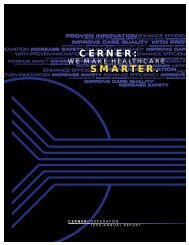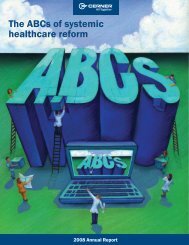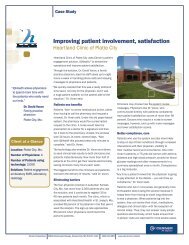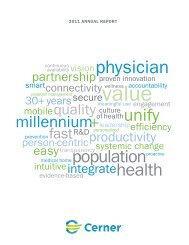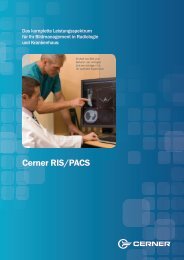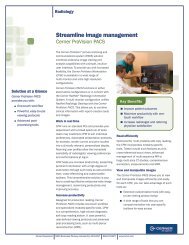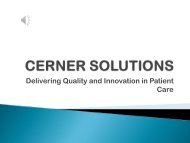Download the Full Report - Cerner Corporation
Download the Full Report - Cerner Corporation
Download the Full Report - Cerner Corporation
Create successful ePaper yourself
Turn your PDF publications into a flip-book with our unique Google optimized e-Paper software.
MANAGEMENT’S DISCUSSION AND ANALYSIS OF FINANCIAL CONDITION AND RESULTS OF OPERATIONS<br />
Year Ended January 3, 1998, Compared to Year Ended December 28, 1996<br />
The Company’s revenues increased 30% to $245,057,000 in 1997 from $189,107,000 in 1996.<br />
Net earnings increased 84% to $15,148,000 in 1997 from $8,251,000 in 1996. Net earnings from <strong>the</strong> Company’s foreign<br />
operations decreased to $2,389,000 in 1997 from $2,897,000 in 1996.<br />
Revenues – In 1997, revenues increased due to an increase in system sales and support of installed systems. System sales<br />
increased 39% to $170,906,000 in 1997 from $122,836,000 in 1996. This increase in system sales resulted primarily from an<br />
increase in installations under Health Network Architecture (HNA) contracts. HNA contracts were 57% of total systems sales<br />
in 1997, compared to 43% in 1996. The sale of additional hardware and software products to <strong>the</strong> installed client base<br />
decreased 8% in 1997 as compared to 1996.<br />
Total sales to <strong>the</strong> installed base in 1997, including new systems, incremental hardware and software, support and maintenance<br />
services, and discrete services, were 73% of total revenues in 1997 compared to 79% in 1996. The lower percentage was<br />
primarily due to <strong>the</strong> increase in system sales to new clients.<br />
At January 3, 1998, <strong>the</strong> Company had $198,274,000 in contract backlog and $132,842,000 in support and maintenance<br />
backlog, compared to $110,330,000 in contract backlog and $107,255,000 in support and maintenance backlog at <strong>the</strong><br />
end of 1996.<br />
Support and maintenance revenues increased 20% in 1997 compared to 16% in 1996. This increase was due primarily to <strong>the</strong><br />
increase in <strong>the</strong> Company’s installed and converted client base. These revenues represented 28% of 1997 total revenues and<br />
30% of 1996 total revenues.<br />
O<strong>the</strong>r revenues decreased 38% to $5,438,000 in 1997 from $8,841,000 in 1996. This decrease was due primarily to a<br />
decrease in real estate lease revenues from <strong>the</strong> rental to outside tenants, as <strong>the</strong> Company utilizes more office space, and <strong>the</strong><br />
reporting of certain services revenue as system sales in 1997.<br />
Cost of Revenues – The cost of revenues includes <strong>the</strong> cost of computer hardware and sublicensed software purchased from<br />
computer and software manufacturers for delivery to clients. It also includes <strong>the</strong> cost of hardware maintenance and sublicensed<br />
software support subcontracted to <strong>the</strong> manufacturers. The cost of revenues was 29% of total revenues in 1997 and 31% of<br />
total revenues in 1996. Such costs, as a percent of revenues, typically have varied as <strong>the</strong> mix of revenue (software, hardware,<br />
services and support) components carrying different margin rates changes from period to period. The decrease in <strong>the</strong> cost of<br />
revenue as a percent of total revenues resulted principally from a decrease in <strong>the</strong> percent of revenue from computer hardware<br />
and sublicensed software, which carry a higher cost of revenue percentage.<br />
Sales and Client Service – Sales and client service expenses include salaries of client service personnel, communications<br />
expenses, and unreimbursed travel expenses. Also included are sales and marketing salaries, travel expenses, trade show<br />
costs, and advertising costs. These expenses as a percent of total revenues were 34% in 1997 and 1996. The increase in total<br />
sales and client service expenses is attributable to <strong>the</strong> cost of a larger field sales and services organization and marketing of<br />
new products.<br />
Software Development – Software development expenses include salaries, documentation, and o<strong>the</strong>r direct expenses incurred<br />
in product development and amortization of software development costs. Total expenditures for software development,<br />
including both capitalized and noncapitalized portions, for 1997 and 1996 were $54,524,000 and $43,133,000, respectively.<br />
These amounts exclude amortization. Capitalized software costs were $18,373,000 and $13,240,000 for 1997 and 1996,<br />
respectively. The increase in aggregate expenditures for software development in 1997 is due to development of HNA<br />
Millennium products and development of community care products.<br />
General and Administrative – General and administrative expenses include salaries for corporate, financial, and administrative<br />
staffs, utilities, communications expenses, and professional fees. These expenses as a percent of total revenues were 9% in<br />
1997 and 10% in 1996.<br />
Interest Income, Net – Net interest income was $2,314,000 in 1997 compared to $2,301,000 in 1996.<br />
Income Taxes – The Company’s effective tax rates were 38% and 36% for 1997 and 1996, respectively. The lower 1996<br />
tax rate is due to <strong>the</strong> utilization of foreign net operating losses.<br />
C ERNER<br />
CORPORATION<br />
ANNUAL R EPORT 17



